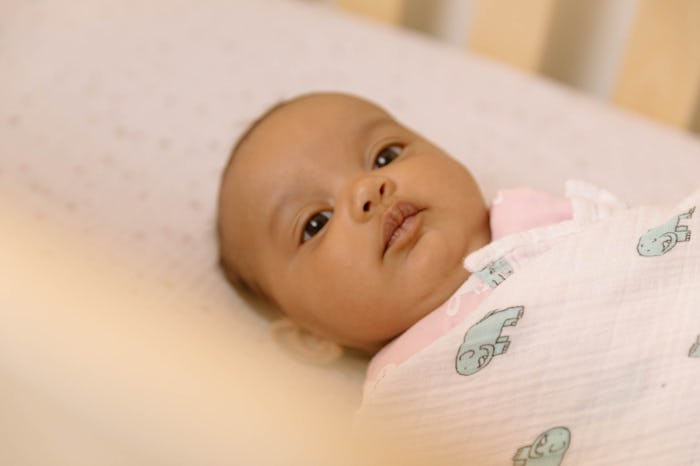Life

Will Babies Get Too Hot In Fleece Swaddles? Here's What New Parents Need To Know
Mimicking the safe space created by a womb can be tricky. An excellent way to replicate the same comforting feeling your baby enjoyed for 40 weeks (more or less) is by swaddling. It can calm the startle reflex, which can disturb an otherwise good night's sleep, and aids in keeping your baby warm until their own body begins self-regulating their temperature. So what should you dress a swaddled baby in? For instance, will babies get too hot in fleece swaddles? Overheating is an issue, so there are more than a few things new parents need to know before relying on a fleece swaddle during those cold winter months.
For starters, it turns out that it really doesn't matter what's going on with the weather outside. In general, babies should be dressed in light layers, preferably cotton, according to CNN. Cotton tends to be more breathable than a lot of other fabrics, especially fleece. Whether used for dressing or swaddling, there's much debate over the use of fleece on babies at all, due to its inability to allow the body temperatures to self-regulate. Experts, like midwife Angela Adam, warn parents that because of the synthetic materials used to make fleece, babies can easily overheat.
The American Academy of Pediatrics (AAP) states that overheating is linked to a potential cause for sudden infant death syndrome (SIDS). As a result of the aforementioned warning, The Baby Sleep Site suggests that once your baby is out of the newborn phase, using a lightweight sleepsack is ideal if you still choose to swaddle. Ultimately, no matter what age your baby is, if you're using a swaddle it's suggested that you end up choosing cotton over fleece.
If you've already used fleece to swaddle, but aren't sure if it's hurt or helped your baby, touch their neck, limbs, or chest. If their skin is hot to the touch, remove the fleece immediately. Likewise, if you notice a heat rash or your baby spikes a fever with no sweat, you should do something to cool your baby right away. Bring in a fan (which is said to reduce the risk of SIDS by 72 percent), remove any extra, unnecessary layers, and turn your room temperature thermostat down to a comfortable 65-70 degrees. The Mayo Clinic highlights signs of rapid heartbeat that may indicate heatstroke, so after attempting to cool the baby, and your room, you should also call your doctor to ensure your baby hasn't sustained a serious injury.
Typically, it seems as though you're much safer using a lighter swaddle as opposed to fleece anything. Not only is fleece not a breathable material, but it usually isn't the fleece from a sheep and, instead, may contain synthetic materials made from plastic. Of course there's eco-friendly versions, but in terms of allowing a baby's body temperature to self-regulate, cotton is far superior, as are many other options. By taking all the necessary precautions and keeping a house cool enough, your baby shouldn't overheat in a traditional swaddle either, but it's always best to ask your doctor and/or research any available options before trying something new, especially a fleece swaddle.
It's sometimes hard to know if your baby is too hot or too cold, because they can't articulate what they're feeling. The answer is clear, though. By avoiding fabrics including, but not limited to, fleece, and choosing cotton and/or cotton blends that allow breathability, the chance of your baby overheating is greatly reduced, as well as the risk for SIDS. Nothing is guaranteed, though, which is why research and continual assessment and awareness when utilizing swaddles, matters. If you're going to swaddle your baby, no matter what fabric you choose (though fleece doesn't appear to be the right choice), or how you dress them beneath, check and double their body temperature and your surroundings for increased safety and the chance at a good night's sleep.
Watch Romper's new video series, Romper's Doula Diaries:
Check out the entire Romper's Doula Diaries series and other videos on Facebook and the Bustle app across Apple TV, Roku, and Amazon Fire TV.